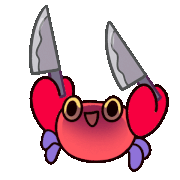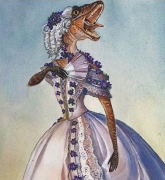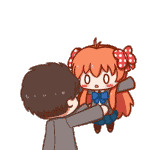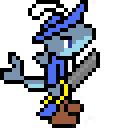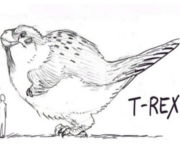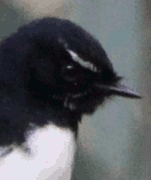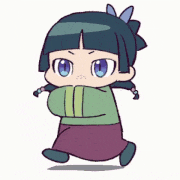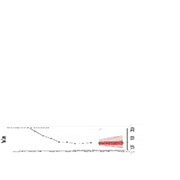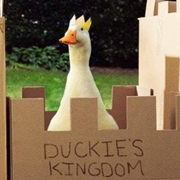|
Thesaurus posted:I recently learned of the giant Moa of new Zealand. It's crazier to me to hear about giant fauna that only went extinct very recently I was actually going to mention this! Apparently after the moas went extinct the haasts eagle started going after the other thing roughly that size. There's evidence of human skulls with deep claw like scratches in them.
|
|
|
|

|
| # ? May 7, 2024 05:12 |
|
Also my buddy's band back in the day floated the name haasts eagle, but people kept thinking they were hot seagull. So they named their ep hot seagull.
|
|
|
|
Jimbone Tallshanks posted:I like glyptodons. Yeah, I airways thought those were fun. Kinda reminds me of a capybara carrying around its own mobile home now.
|
|
|
|
Imagine how human history might be different if we constantly had the threat of eagles picking us off. Yeah we have stuff like sharks and tigers and bears but they have limited range and can't sneak up on you.
|
|
|
|
I saw a Golden Eagle (I think that's the name) in central Australia, on the road eating a dead kangaroo. I stopped my car and it saw me then took off, but it was like a jumbo jet taking off, so long and slow and huge and it's like, can he fly? But yeah, there he went. HUGE. An eagle that size could easily take out a kid or even a small adult, no problem, if it wanted to.
|
|
|
|
a few years ago when I first moved up here I was mushroom hunting in the dunes with a buddy of mine and he said the biggest bird he'd ever seen landed a few dunes over and I was thinking it could.be a rogue condor that came up the coast and we crept up all sneaky like to get a view and it was just a turkey vulture and turns out he was very bird ignorant
|
|
|
|
Comstar posted:
These are the same guys that did Man After Man, which I always had a huge problem with because it never gives a reason on why humanity would bio engineer slave races to do its work, when machines could do the same jobs? At least All Tomorrows has humans making a race that can colonize the stars, while all the weird poo poo is actually due tot he Qu loving poo poo up for fun.
|
|
|
|

|
|
|
|
twistedmentat posted:These are the same guys that did Man After Man, which I always had a huge problem with because it never gives a reason on why humanity would bio engineer slave races to do its work, when machines could do the same jobs? At least All Tomorrows has humans making a race that can colonize the stars, while all the weird poo poo is actually due tot he Qu loving poo poo up for fun. Because lots of people like making other people miserable and holding power over them in some way. You can't subjugate a robot in a way that makes your broken corpo fascist dick hard.
|
|
|
|
titty_baby_ posted:a few years ago when I first moved up here I was mushroom hunting in the dunes with a buddy of mine and he said the biggest bird he'd ever seen landed a few dunes over and I was thinking it could.be a rogue condor that came up the coast and we crept up all sneaky like to get a view and it was just a turkey vulture and turns out he was very bird ignorant To be fair a bird landing or taking off real close makes more of an impression. the first time I accidentally flushed a great blue heron fron a few feet away, my hind brain was screaming that it was some kind of dinosaur
|
|
|
|
Do you ever think that while you were out walking today you may have thoughtlessly crushed the plant or insect carrying the mutation that would have led to whole new branch on the tree of life? That you just sprayed disinfectant on a bacteria that only eats cancerous cells?
|
|
|
|
Funky See Funky Do posted:Do you ever think that while you were out walking today you may have thoughtlessly crushed the plant or insect carrying the mutation that would have led to whole new branch on the tree of life? Exactly why I stomp on every bug I see
|
|
|
twistedmentat posted:These are the same guys that did Man After Man, which I always had a huge problem with because it never gives a reason on why humanity would bio engineer slave races to do its work, when machines could do the same jobs? At least All Tomorrows has humans making a race that can colonize the stars, while all the weird poo poo is actually due tot he Qu loving poo poo up for fun. What? No, Man After Man was Dougal Dixon, the guy who did After Man and The New Dinosaurs
|
|
|
|
|
Asterite34 posted:Gotta go to bat for all the weird Pseudosuchian archosaurs of the Triassic, especially the Aetosaurs and "rauisuchians." So one of the reasons I'm doing this big effort post on Cenozoic South America is because I find the whole era and place uniquely fascinating, in large part because so much of it actually comes across as some kind of weird throughback to the Mesozoic, especially the Triassic 200 million years earlier. Like then you have archosaurs dominating the large predator roles in both varieties of Crocodile-line Sebecids and Theropod-line Phorusrhacids, alongside various types of mammals that themselves could come from lines typically seen as 'more primitive' than modern mammals, with the biggest animals in the environment coming having a superficial resemblance from their long lost cousins like Dicynodonts, and other mammals consistently converging on similar habits and appearances as dinosaurs.  First some context, after the K-Pg extinction South America was essentially an island continent cut off from the rest of the world, but with some tenuous and fascinating connections North, South and East we will get to later. Being a gigantic island having just come out of a world-wide mass extinction that killed off large animals it meant there was a massive amount of room for things to develop in extremely strange directions as various groups jostled to occupy all those sweet, sweet new niches.  South America had a lot in common with Australia and to a lesser extent Africa in being cut off from the rest of the world like this with time to develop unique fauna, like Australia it ended up being a major holdout for Marsupials, current day American marsupials (Didelphimorphia) number in at 126 species, including its most famous member, the Virginia Opossum who's ancestors was one of the creatures that moved north after the great American interchange. Extinct marsupials seem to have occupied a wider range of niches, of note here is Argyrolagus that seems to have been similar to living kangaroo rats and springhares.   Unlike Australia there were also a lot more placental mammals that made it through to the Cenozoic, but even then they tended to be part of unusual groups quite specific to South America, of note are the Xenarthrans, Notoungulates, Astrapotheres, Litopterns and Pyrotheres, the latter four groups here being called 'South American Native Ungulates' (ungulates being hooved animals).  Xenarthrans are still alive, and are some of the most recognizably 'American' animals still around, they currently consist of Sloths, Armadillos and Anteaters, their distinguishing characteristics are unusual teeth that are missing enamel you find in most other mammals, very tough, reinforced and powerful skeletons that give them more strength than you would expect, and a lower body temperature than almost any other mammals that mean they can subsist on less food overall. They are sometimes seen as the most 'primitive' living placental mammals though that's not really fair, every species we know of, living or dead, is entirely confined to North or South America, with Armadillos having spread north well into the United States after the great American interchange and being probably the most successful animals of South American origin in the North. Xenarthrans seem to have the closest affinity with Afrotheres, that is a group of animals that originated in Africa, in surprisingly similar circumstances of being placentals cut off from the rest of the world after the K-Pg extinction, and whose members include things like Elephants, Sea Cows, Hyraxes and Aardvarks. While everybody loves a good living Anteater or Tree Sloth, extinct Xenarthrans are on a whole other level, the most famous members of this group are the infamous Ground Sloths. For tens of millions of years they occupied a major role in the ecosystem as a ground level browsing animal, with a partially bipedal motion that facilitated them being able to rear up to higher levels to eat plants further up, helped further by long claws they could use to pull down leaves and scrape at bark, and disembowel a predator too if it came to it. This particular arrangement sounds very unusual, but seems to have recurred several different times in very different animal groups, other examples are Therizinosaur dinosaurs and Chalicothere Perissodactyls, the closest living analogues to this way of life are probably Gorillas actually. Ground Sloths have long been important animals, but in the last several million years of their existence they seem to have started to occupy the role of gigantic herbivores when some animals that previously occupied this role went extinct, they also started to move into North America with the great interchange, giving rise to their largest and most widespread members like Eremotherium, which was the size of a large elephant, potentially exceeding 6 tonnes and 6 metres long.  There were lots of smaller ground sloths of course, especially before these giants in times like the Miocene about 15 million years ago, its actually been a point of controversy in recent years if the big species had the shaggy fur that people have come to associate with Ground Sloths, which were based on remains found from smaller species who only died out in the last ten or twelve thousand years and include genus like Mylodon. These animals weren't small of course, comparable in size to things like large horses or moose.  While ground sloths where doing their thing, another group of Xenarthrans were really getting into cosplaying as Ankylosaur dinosaurs, the Glyptodonts. Interestingly, recent research has indicated that Glyptodons are fundamentally just a type of armadillo, if we go by the rules of phylogenetic bracketing, they are seated within the armadillos and are more closely related to Six Banded and Fairly Armadillos than those species are to other types of armadillos. Previously it was thought that Glyptodons were a separate group closely related to Armadillos. Either way, the main thing that distinguished Glyptodon's was a diet grazing on grass, extremely heavy armour and accessories, and stupendous size compared to their living relatives. The largest Glyptodonts (which like Ground Sloths appeared near the end of their time on earth) really go all in on the Ankylosaur cosplay, Doedicurus could weigh up to 2 tonnes, was 3.6 meters long, had nigh-impenetrable armour and even sported a long spiked club at the end of its tail which it probably fought predators and other members of its species with. For comparison, this put it into a comparable size range as some species of Ankylosaur like Euoplocephalus. Other Glyptodons had shorter tails with less armament but they still seem to have been covered in armour and likely twacked each other with them. Like Ground Sloths Glyptodonts spread north into North America during the Pleistocene before their extinction.   Xenarthrans at least still have living members, but sadly the next groups of home-grown South American didn't leave any descendants, though they came excruciatingly close. These are the so called 'South American Native Ungulates', and are sometimes collectively grouped into Meridiungulata, though they were a much more disparate group than their name implies. Their evolutionary relationships are obscure, they were certainly most closely related to each other, but I think that the current consensus is that their closest living relatives are Perissodactyls, aka 'Odd Toed Ungulates' that consist of living horses, rhinos and tapirs, and certainly SANU seem to have converged on very similar lifestyles and appearances a lot of the time. Pyrotheres were one of the earlier groups, looking like giant tapirs and dominating up until the Oligocene about 20 million years ago before dying out.  In their wake, Astrapotheres took on very similar niches and became the most important large herbivores of the Miocene until their extinction about 6 million years ago. Superficially they had a weird resemblance to Elephants and some species like Hilarcotherium could rival them in size, with short trunks and large tusk like canines that grew continuously throughout their lives.    After the demise of the Astrapotheres, the Notoungulates took over a lot of their niches and grew very large, very quickly, having been previously represented by animals more comparable to big rats they ended up producing the likes of Toxodon and Mixotoxodon that were more in line with a big hippo or rhinoceros but with teeth similar to that of a rodent. These animals survived to the bitter end, past the great American interchange, with Mixotoxodon even finding its way into the Southern United States, and only dying out in the last 10000 years.   Some Toxodontid Notoungulates even evolved horns to complete the confusingly rhino-like look, as can be seen in Hoffstetterius.  The last group of SANU's I'm going to mention are the Lipoterns, while the previous animals seemed to converge on big bulky forms, these guys went for much more lithe, graceful body plans and put a premium on outrunning their threats, a lot of them closely resemble things like Camels, Horses and Llamas and evolved cursorial adaptations like reducing the number of toes down to one (in the case of Thoatherium below), like Horses do. Like Notoungulates some of this group lasted almost to the present day, with the final, and largest, representatives, Macrauchenia, dying out circa 12000 years ago, along with the much smaller Neolicaphrium.     Now, I've talked a lot about the various herbivorous animals that filled up the landscape of ancient Argentina or Colombia those millions of years ago, and between the big size, thick armour, running adaptations and huge claws its quite noticeable that most of these creatures were evolving defence mechanisms you would expect against considerable predation pressure, but what predators might they be I hear you ask? While South America's animals were already weird this is where things get even weirder, South America has the unusual distinction of being probably the only major landmass where the top land predators weren't some species of mammal, and even the mammalian predators that did exist were weird and distinct from the typical carnivorans that came to dominate elsewhere. Instead what you had were archosaurs doing their best to channel the power of their ancestors and not surrender their ancestral rights to those upstart mammals just because the earth got smacked by a giant rock. Ok I don't know why I'm being so coy about this when you can see the giant bird in second image eating a Notoungulate so I'll just get into it. The most infamous South American predators of the Cenozoic are Phorusrhacids, and it feels fitting to be talking about these guys after all that earlier talk about deadly birds. Colloquially people have been calling these 'Terror birds' for some time and I can't think of a more fitting name, they basically just re-evolved into Dromaeosaurid dinosaurs and occupied the role of most common and long lasting land predators, dominating the landscape for over 50 million years and occupying a wide variety of niches, as you can get the impression of below:  Terror Birds have had a lot of controversy about their overall modes of life, which isn't helped by the fact that their remains are scattered, fragile and rare, for a long time there was a ton of debate about things like overall size, bite force, how they killed prey and what kinds of prey they hunted. One of their most notorious members, Brontornis, has controversy about whether its actually a terror bird at all. Generally it seems that Phorusrhacids are unusual in being big extinct predators that scientists and the media probably didn't give enough credit for for the longest time, a lot of older research tended to suggest that they were restricted to small game (like living maned wolves), and capped off at about 150 KG, but more recently there has been considerable pushback to this and its instead we have increasing evidence that they were much bulkier than previously thought and hunted much larger game by driving their massive, heavily hooked beaks into them with powerful neck muscles rather than relying on a powerful bite. This actually seems to suggest they converged on a similar killing strategy as saber-toothed cats, which are also noteworthy in having relatively weak bite forces. Despite what you may hear its also almost certainly not the case that Phorusrhacids were 'outcompeted' by the 'more evolved' predators from North America, this ridiculous notion is mostly driven by long running prejudices about Carnivorans being the ultimate predators. Phorusrhacids are the only South American predators that managed to successfully expand their range northward, and it seems that the North American species, Titanis, was so successful it might have actually suppressed large cat species from evolving while it was alive, and it was able to thrive in North America for 3 million years. Its notable that North American carnivorans only move south into South America after the large Phorusrhacids already went extinct, and the current consensus is that Phorusrhacid extinction was probably caused by climate shifts rather than competition with other predators. The infamous Smilodon Populator actually seems to have only evolved to occupy a niche that would have been left by Phorusrhacids after they died out. Anyway, sorry for that tangent, but I just really find these animals cool and think they deserve some drat respect, the biggest Phorusrhacids were absolute units. Kelenken is most notorious, this animal has the distinction of possessing the largest head ever found in a bird, at 2.3 feet long its skull was bigger than that of a horse and mostly filled with its huge, sharp beak. Based on some recent estimates I've read it was probably up to 300 kilograms (its hard to get an exact estimate with the limited material we have) and it was about three meters tall, this thing was comparable to a very large modern day Siberian tiger, and even the biggest Dromaeosaurs like Utahraptor.   Phorusrhacids seem to have been well adapted towards running, and generally did well as the plains started to expand during the Miocene, at the expense of other predators, some estimates have suggested that even the larger ones could have reached speeds in the range of 50 KMH, some of them seemed to have almost turned into the Avian equivalent of cheetahs, at a similar size putting extreme focus on speed to hunt down prey who also had an extreme focus on speed, like some of the Lipoterns mentioned above, an example of this was probably Mesembriornis where some estimates based on its leg structure suggest it could match a Cheetah's top speed.  Phorusrhacid legs have also been suggested to have allowed them to leverage them into weapons, kicking prey to death like modern secretary birds has been suggested for some of the smaller species that might have had similar lifestyles, and maybe also an option for the big ones that had big claws that share a resemblance with those infamous Dromaeosaur sickle claws.  The last surviving Phorusrhacids are again difficult to determine, the evidence is very fragmentary, but it might have been the more conservative Psilopterans who went in for a niche of eating small animals, there's a small possibility they could have made it just in time to see the first humans reach South America. Their closest relatives alive today are Seriemas, long legged birds who hunt for small animals in the grasslands of South America.   Another particularly controversial bird to note here is an animal called Brontornis, this lived during the Miocene and it seems to have been one of the largest birds that ever lived, based on its bulky bones it might have reached 400kg. Initially this animal was considered a Phorusrhacid and if so it would be a real titan, comparable in size to a Kodiak Brown Bear, but there has been a ton of controversy in the literature about if it was even a Terror Bird at all (somewhat ironic when it gives its name to an entire subfamily within Phorusrhacidae) with a lot of recent researchers arguing instead it was a giant Anseriform, that is to say a really big duck, and probably herbivorous. Funnily enough this is similar to the controversy of another giant, extinct bird called Gastornis from the Northern Hemisphere during the Eocene, which was originally argued to be a predator and recent research has shown much more convincingly to be a herbivore. I'm not the most well up on the current state of thinking with Brontornis, but I've heard that there's actually been some evidence and research supporting the Phorusrhacid affiliation again, if that is the case it would be the largest Phorusrhacid known and the largest predatory bird ever, but I'm not going to take a side and I'll just post a neutral looking picture.  The last thing I want to say about Terror Birds is the prospect of them existing outside of South America. We have indisputable proof that they made their way to North America and lived there for millions of years with the aforementioned Titanis, but that's not the most surprising thing considered the great American interchange. More interesting to me is that there are some fossils in Europe and North Africa that have been tentatively assigned to the group, suggest a wider distribution during the Eocene but these are extremely tenuous and I'm pretty sceptical of them. Instead, what really gets me excited is that there seems to be very strong evidence that they found their way to, of all places, Antarctica, where if this study is correct they seem to have reached large sizes much earlier than previously thought. In addition to Terror Birds, there's also signs that Notoungulates and other groups considered purely South American lived in Antarctica, suggesting an enticing possibility that there was a well developed ecosystem of animals originated from South America in the southernmost continent who ultimately went extinct as the Ice Caps took over everything. It fascinates me to imagine what fossils lie beneath the ice.   Phorusrhacids might have been formidable, but one of the most shocking things about Cenozoic South America is that they weren't even the largest predators knocking around. That honour goes to another group of Archosaurs reliving the glory days, Sebecid Crocodylomorphs. Unlike Phorusrhacids we have much stronger evidence that they had a much wider distribution across the world before South America was isolated, Sebecid fossils have been found in Europe, and interestingly they have been firmly dated to have existed before the K-Pg extinction, meaning the group was able to survive the event and make it through. The early European members of the group started off small, about a meter in length, and grew to be significantly larger as predatory niches opened up in the aftermath of the dinosaurs, but it was in South America that they really got things into gear properly. Sebecids seem to have been fully terrestrial, unlike living crocs, they weren't even technically crocodilians proper, falling outside the group of true crocs. Not that that stopped them, they seem to have converged on very similar body plans and lifestyles as Triassic Rauisuchian (although I know that group is poorly defined), big land living predatory animals on four legs, and they could get absolutely massive. The biggest member of the group is a notorious creature called Barinasuchus, this has the distinction of being probably the largest land predator of the entire Cenozoic, outclassing every predatory mammal and reaching a weight potentially up to 1.5 tonnes, with a length of up to 6 meters. This meant that a large Barinasuchus could have approached the dimensions of some big Theropod dinosaurs like Albertosaurus and Allosaurus, in fact the only non-theropod land predator that ever matched or exceeded it in history might have been the Triassic Fasolasuchus. Pretty much nothing could threaten it in its environment, and they seem to have lasted a long time, going from the Eocene all the way to Miocene, dying out about 11 million years ago as the last and largest of its kind. It seems to be the case that the Sebecids, despite their initial success, couldn't compete as the world got colder and colder into the Miocene and the forests and swamps began to give way into wide open plains, where the Phorusrhacids did better better than the Sebecids.   Of course, crocodilians are more well known for their aquatic habits, and Cenozoic South America seems to have offered extremely favourable conditions for that, from what I've read the Amazon flowed the opposite direction to how we are used to today, in the Cretaceous it went out on the Pacific coast but over time the formation of the Andes seems to have reversed this and there seems to have been an absolutely massive system of lakes and waterways across northern South America at a point about 15 million years ago.  In these waters you got some massive or unusual versions of modern day animals, including a giant turtle called Stupendemys and a strange filter feeding crocodilian called Mourasuchus with a pelican-like jaw and throat pouch.   But swimming in these waters was also an absurdly large caiman, Purussaurus, known only from its gigantic, bulldog like skulls, seems to have been one of the largest Crocodilians of all time. Its overall size is hard to determine when you only have skulls, but I've seen lengths of up to 10 meters and weights in excess of 5 tons frequently given as reliable, with more ostentatious estimates going much higher based on other methods. This animal lived all the way through the Miocene and almost certainly would have been the largest predator in these northern waterways, capable of eating almost anything that ventured into the water with the possible exception of the largest Astrapotheres.   Of course, with all of this talk about Archosaurs, I shouldn't lose sight of the fact that there existed another major guild of predators in South America that, probably unsurprisingly by now, came from a very unlikely group, these are the main mammalian predators of the region, the Sparassodonts. Sparassodonts are strange animals that seem to have been closely related to living marsupials, but fall just outside of the group on their own. They were exclusively found in South America according to our current knowledge, and ended up taking on a lot of roles filled by mammalian carnivores elsewhere, with a lot of convergence between them and things like cats, mustelids and hyenas. Generally they couldn't hope to compete with the Sebecids and Phorusrhacids as large predators but did well in smaller roles of being ferret or fox like animals like Lycopsis, and some like Proborhyaena or Thylacosmilus approached the size of a big cat like a leopard.   Thylacosmilus is easily the most famous member of this group, and its a classic case of convergent evolution, or rather, it was a classic case of convergent evolution. The massive canines that come with complete with their own protective sheath clearly brings to mind Smilodon and some other sabre tooted Synapsids like Hoplophoneus, and suggest that it was an active predator that leveraged its huge teeth and massive gape to cut through the necks of its prey to swiftly dispatch them like Smilodon seems to have done. However, there's been some recent research that's thrown a lot of cold water on the assumptions about how Thylacosmilus used its teeth, making particular note that the tooth shape of Thylacosmilus differed from other sabre-tooths and its lack of incisors is hard to explain with comparisons to them, among other things. Said study admits they can't really offer an explanation of how the animal lived, beyond a weak suggestion of the endlessly problematic concept of being a full time scavenger (Jesus Christ do not even mention Jack Horner around me), I've heard that some more recent studies counter this study, as Palaeontology usually does. Whatever the case, Thylacosmilus was one of the last of its kind, the Sparassodonts died out around the Pliocene, 5 million or so years ago, missing out interacting with North American arrivals (who also did not contribute to their extinction), leaving the Phorusrhacids as the last man standing of the old South American predators. There seems to have been a general extinction event going on that probably ended about 2 million years ago that particularly affected the Predators of South America, leaving the way open for North American Carnivorans to move south and occupy the newly opened niches.   Of course, that's run through almost all of the major predators I wanted to cover, but I have one last group that's worth mentioning, already touched on a bit in Milo and POTUS's post earlier, the Teratorns. These are some of the largest flying birds, if not the largest (at least in terms of weight), that ever existed. They seem to have been closely related to New World Vultures (think Turkey Vultures) and its often been assumed that they had similar scavenging habits, but to my understanding research has actually indicated they were better suited for active predation and probably soured over the grasslands looking for small prey to prey to pounce on. Of course, when I say 'small', they likely could have hunted much larger animals than the average eagle considering their sheer size. The largest member is the famous Argentavis Magnificens, this bird could have weighed up to 70 kilograms, the same size as a small person, and had a wingspan up to 6.5 meters. Argentavis could have competed with some very large Pterosaurs in terms of size, though not up to Azhdarchid measurements, and probably would have been able to threaten most other predators on the ground apart from the large Phorusrhacids to steal kills as it soured over huge areas. Teratorns also made their way up to North America, their remains are common in the La Brea tar pits, though Argentavis would have been long dead by then and the entire group died out in the Pleistocene.   So far I've almost exclusively talked about animals that descended from taxa that were probably present in South America from before the K-Pg extinction, but this is actually a little bit misleading. One of the strangest elements of Cenozoic South America is that there was something of a conveyor belt depositing random animals from western Africa in South America that then went on to diversify into major parts of the ecosystem. It seems to have been the case that the much shorter distance between South America and Africa as the Mid Atlantic rift was still relatively young, combined with favourable winds and currents, island chains that have since disappeared, and frequent tropical storms washing out animals and rafts of plant matter out to sea conspired to allow the flow of some small animals across the Atlantic during the first half of the Cenozoic, before the widening ocean shut off this delivery service. The two most famous groups this resulted in are the Caviomorph Rodents and the New World Monkeys (Platyrrhini). These include a lot of currently living species like Capybaras, Tamarins, Spider monkeys and Maras.     I find this really fascinating because its an insane idea that these animals crossed an ocean to find their way to the Americas, and I think a lot of people assume that they probably descend from species that moved south from North America, but they don't, they are true natives of South America, and have been there a long time, the earliest Caviomorphs probably reached South America around 45 million years ago and monkeys followed them around 35 million years ago. Accordingly we can see that they have long been an integral part of the ecosystem, both groups even found their way up to the Caribbean later on by a similar process, but that's a story for another day.  The rodents in particular are worthy of attention, Cavy type rodents are already kind of odd and stand out compared to rats or hamsters, they include the largest living species of rodent today, the Capybara, and things like the North American porcupine, but their extinct relatives were a step beyond. The largest known rodents in history were Caviomorphs from the Miocene and Pliocene that seem to have occupied niches usually reserved for things like Tapirs or other large Ungulates. Josephoartigasia massively outsized the living Capybara, weighing up to half a ton. Another large rodent was in the Phoberomys genus and lived during the Miocene. Even to this day, Capybaras are still the most abundant herbivore throughout a lot of South America, so less has changed than you might think.   The last couple of animals I want to mention are two unexpected things, the first is Monotrematum, this is actually a kind of Platypus, it from about 61 million years ago, just after the K-Pg mass extinction and one of the only known Cenozoic monotremes found outside of Australia. The second is a curious creature called Necrolestes, found much later on during the Miocene it resembled a mole, but that's only because mammals have an impossible urge to constantly evolve into being moles just like Crustaceans yearn to be crabs. Its evolutionary relationships are fascinating because its not a Placental or a Marsupial, its part of an extremely ancient group called Meridiolestids that were common small mammals before and just after the dinosaur extinction, with poor old Necrolestes being the last of its kind literally forced underground. We can't know for sure but they might have even laid eggs, either way it shows just how much of a refuge South America was for strange and ancient animal groups during its tens of millions of years on its own.   Well I hope everyone enjoyed that, I might do another effort post in the future about another, hopefully smaller, topic like Pleistocene Australia or the extinct animals of the Caribbean. I cribbed a lot of random art from across the internet for this, and I feel bad that I can't really give proper credit to them all, but of particular note where I got some real good pieces are Nix Illustration and Gabriel Ugueto. Cheers! khwarezm fucked around with this message at 01:52 on Apr 8, 2024 |
|
|
|
I've enjoyed the pictures and I'm on my way to enjoying the rest of the post. Thanks for a great post.
|
|
|
|
https://www.youtube.com/watch?v=6gt0X-27GXM
|
|
|
|
Jimbone Tallshanks posted:I like glyptodons. They could fart fire and teleport two inches in any direction
|
|
|
|
BrigadierSensible posted:Wombats are cool. Well, modern wombats aren't exactly small...   Fun facts - They can run at 40kph - despite being built like beer kegs. rear end is reinforced with cartilage. They use it to crush the skulls of predators (like foxes) who try to invade their burrows. They make cube shaped turds. They are marsupials which means they have a pouch - like a kangaroo. It faces backwards so the mother doesn't fill it up with dirt when she's digging.
|
|
|
|
khwarezm posted:(really excellent stuff) What a fantastic post. I'd like to read more about the australian pleistocene, if you get the chance to write another turbo-post.
|
|
|
|
man I feel smarter now, great post Tree Bucket posted:
Wikipedia posted:Genetic evidence suggests the Steller's sea cows around the Commander Islands were the last of a much more ubiquitous population dispersed across the North Pacific coastal zones. They had the same genetic diversity as the last and rather inbred population of woolly mammoths on Wrangel Island. During glacial periods and reduction in sea levels and temperatures, suitable habitat substantially regressed, fragmenting the population. By the time sea levels stabilized around 5,000 years ago, the population had already plummeted. Together, these indicate that even without human influence, the Steller's sea cow would have still been a dead clade walking, with the vast majority of the population having already gone extinct from natural climatic and sea level shifts, with the tiny remaining population at major risk from a genetic extinction vortex. dead clade walking is a cool username
|
|
|
|
twistedmentat posted:These are the same guys that did Man After Man, which I always had a huge problem with because it never gives a reason on why humanity would bio engineer slave races to do its work, when machines could do the same jobs? At least All Tomorrows has humans making a race that can colonize the stars, while all the weird poo poo is actually due tot he Qu loving poo poo up for fun. Power. Ordering a machine gives you nothing. Also, Sex Slaves!    These all look like they should have an Elephants truck but the Artist didn't want to make them look too much like one. The first one doesn't look like it could use the truck in has either as its legs seem to have been cut in half with no knees. Comstar fucked around with this message at 00:55 on Apr 8, 2024 |
|
|
|
thank you khwarezm for the great post i liked the part about the angry giant parrots
|
|
|
|
khwarezm posted:Another particularly controversial bird to note here is an animal called Brontornis, this lived during the Miocene and it seems to have been one of the largest birds that ever lived... comparable in size to a Kodiak Brown Bear...with a lot of recent researchers arguing instead it was a giant Anseriform, that is to say a really big duck. I want to meet this guy. khwarezm posted:One of the strangest elements of Cenozoic South America is that there was something of a conveyor belt depositing random animals from western Africa in South America that then went on to diversify into major parts of the ecosystem. It seems to have been the case that the much shorter distance between South America and Africa as the Mid Atlantic rift was still relatively young, combined with favourable winds and currents, island chains that have since disappeared, and frequent tropical storms washing out animals and rafts of plant matter out to sea conspired to allow the flow of some small animals across the Atlantic during the first half of the Cenozoic, before the widening ocean shut off this delivery service. Yes, I enjoyed that very much, that's fascinating. Fantastic post OP! I remember watching a computer animated documentary about the creatures of the Paleozoic Era back in the late 90's that were so fierce, strange, and massive that it gave me a fear a deep and dark water to this day. I cannot wrap my head around the scale of some of these animals.
|
|
|
|
GoutPatrol posted:dead clade walking is a cool username "extinction vortex" isn't bad either.
|
|
|
|
Thylacine. oh sorry I thought this was the Still Alive Beasts thread
|
|
|
|
|
Funky See Funky Do posted:Do you ever think that while you were out walking today you may have thoughtlessly crushed the plant or insect carrying the mutation that would have led to whole new branch on the tree of life? That you just sprayed disinfectant on a bacteria that only eats cancerous cells? hell yeah I am become death destroyer of lineages
|
|
|
|
terror birds are cool as gently caress
|
|
|
|
Southern Cassowary posted:terror birds are cool as gently caress Not sure I can trust this username/post combo
|
|
|
|
Everybody just living in the moment, no phones, no social media. Those were the days.
|
|
|
|
hiding from the 8ft tall terror birds because grug stole one of their eggs again
|
|
|
|
Comstar posted:
drat, new Silent Hill is looking pretty good.
|
|
|
|
If anyone remembers this video from 2016 with size comparisons of various dinosaurs, the channel just announced that they're going to release a new version in just a few days https://www.youtube.com/watch?v=rRiecAmGWHU I can also strongly recommend the Your Dinosaurs Are Wrong channel where a palaeontologist uses old dinosaur toys as a starting point to discuss old pre-conceptions of what dinosaurs looked like, and how that has changed and been updated over time https://www.youtube.com/watch?v=u8ffPhdTk14 EoinCannon posted:I sculpted a helicoprion, among other non extinct species for the Australian Museum sharks exhibit which is touring the US at the moment. For some reason I used to think those things were fairly small, probably because the fossils of their teeth whorls are usually the size of a dinner plate. I was pretty surprised to discover that they were larger than a Great White Darth Brooks posted:The Jurassic Park movies need to have a competitor company that focused on bringing back extinct animals from the cenozoic. Mammoths, Cave Bears, Saber Toothed Lions, Wooly Rhinos and the like. There was an ITV series which had elements of this called Prehistoric Park https://www.youtube.com/watch?v=HYDUGtZiVu8
|
|
|
|
Southern Cassowary posted:terror birds are cool as gently caress https://www.youtube.com/watch?v=HOrf31We4ho
|
|
|
|
*Proud farmer looking at my HIGH PEN ELECTRIFIED FENCE free range Terror Birds
|
|
|
|
We have archaeological evidence of a giant ground sloth hunt, which is pretty loving wild. Basically the hunt happened in an area where foot prints preserved well and you can mostly see how the hunt progressed and when the sloth noticed. Uh what else. We have an ash cast of a vulture that's insanely detailed (basically it died in an eruption like those folks in pompeii) Uh, theres a non zero chance that people in the bronze age med at somepoint traded pygmy elephants around, thought the evidence for this is almost not existent Telsa Cola fucked around with this message at 03:31 on Apr 9, 2024 |
|
|
|
Giant ground sloths burrowed and their burrows perserved in a few instances, including their claw marks. The burrows are large. We know of several outcrops and boulders which we think Mammoths rubbed up against because the wear patterns on the stones are similar to those that modern elephants produce
|
|
|
|
Cave hyenas are basically genetically identical to modern spotted hyenas
|
|
|
|
wish I had a tiny elephant
|
|
|
|
There are caves in NA with definite layers of giant ground sloth and mastodon/mammoth poo poo which has preserved fairly well.
|
|
|
|

|
| # ? May 7, 2024 05:12 |
|
titty_baby_ posted:Initially read "Extinct Breasts" and got very curious Excellent username/post combo and also same
|
|
|





:focal(800x602:801x603)/https://tf-cmsv2-smithsonianmag-media.s3.amazonaws.com/filer_public/52/c5/52c54249-65ac-4325-8991-dad3c8261d6f/giant_haasts_eagle_attacking_new_zealand_moa_web.jpg)

